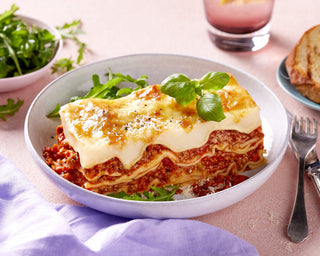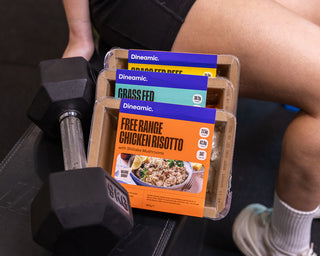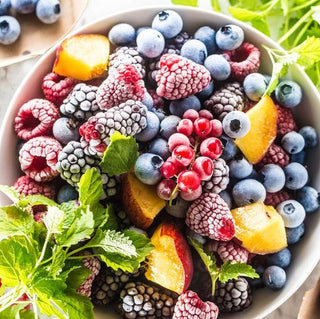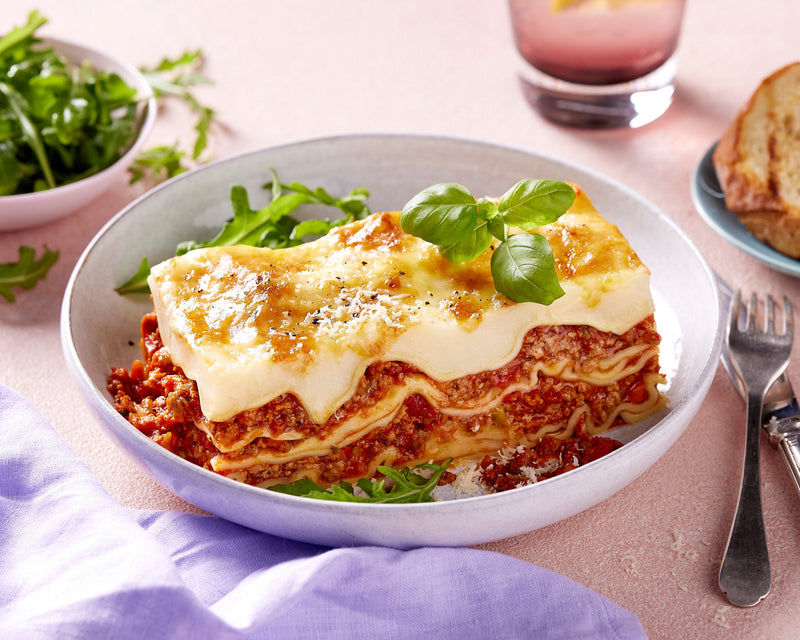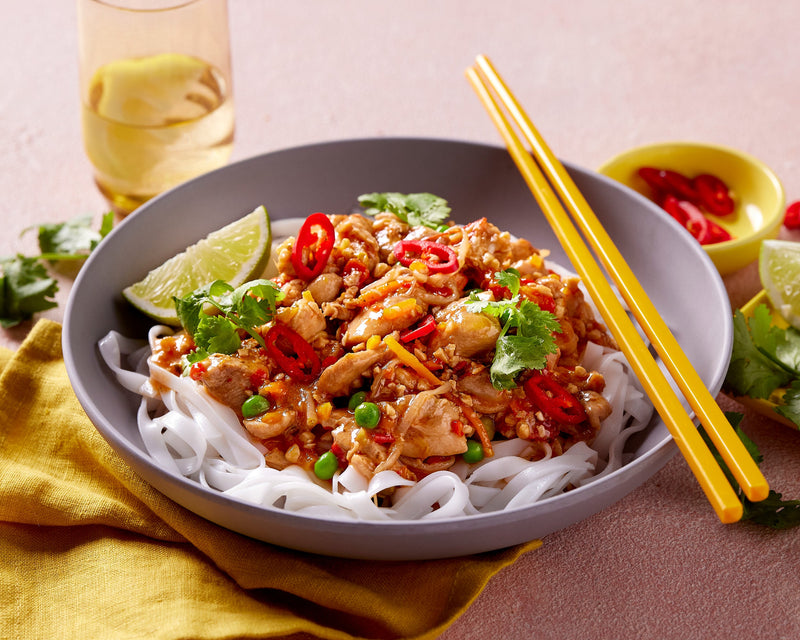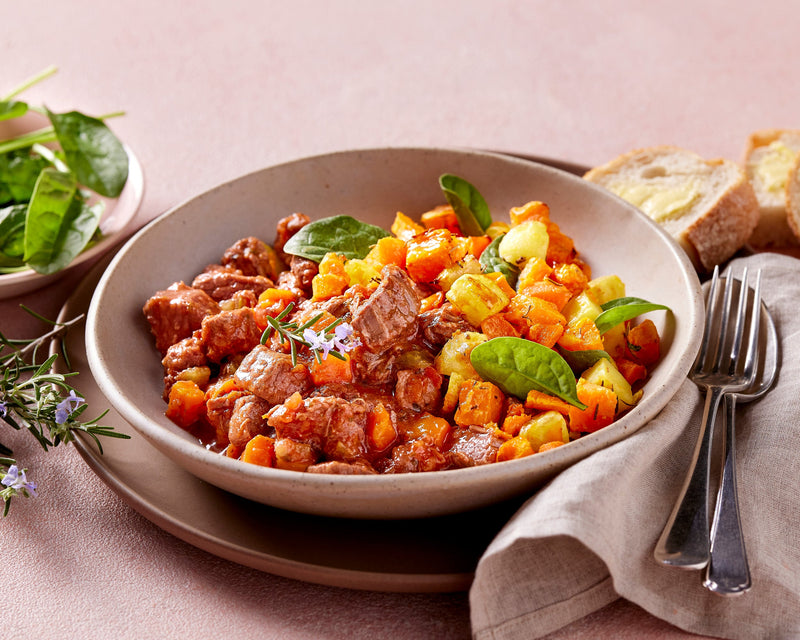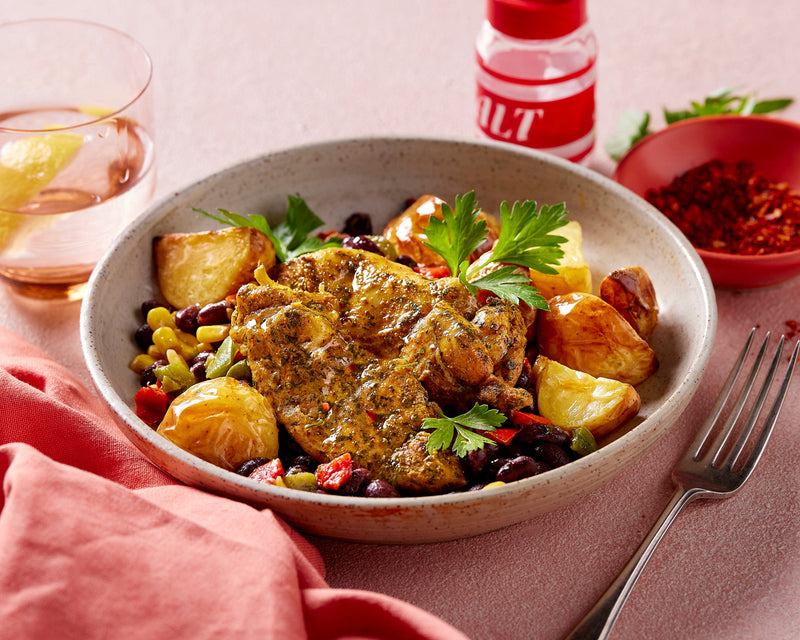When it comes to fresh versus frozen ingredients we often assume that fresh is best, right?
Well… not always. It’s something we get asked about pretty often (what with our food being frozen and all), so here’s a look into the world of freezing food, what it means for you & why we love the mighty freezer so much.
Picture this: That apple you picked up yesterday was actually harvested back in March and sat in storage for months before finally hitting the supermarket shelf. On the other hand, that bag of frozen berries was snapped frozen just hours after harvesting at their peak ripeness bringing you a tender juicy nutritious berry year-round.
We know what we’d prefer.
The Mighty Freezer
Freezing food has existed since early 1000 B.C (how cool is that?!), but it wasn’t until the ‘father of freezing’, Clarence Birdseye famously developed the method of ‘blast freezing’ that it became a culinary revolution.
At Dineamic, we use a ‘cook-chill’ method where our meals are cooked to a certain temperature before rapidly reducing the temperature down to ensure your meals are safe and ready for frozen storage. This is achieved through the help of our beloved blast chiller (the same one you see on MasterChef, except at least 20 times bigger!) The blast chiller works by rapidly dropping the temperature of food down to +3oC in less than 90 minutes, a rate much faster than you would ever find in a conventional home freezer through high velocity fans that force super cold air.
The somewhat spontaneous freezing not only immediately stops the cooking process and stops bacterial growth but also minimises evaporation from the food. This means smaller sized ice crystals and the quality, texture and colour of the food maintained. In comparison, normal freezers like the ones we have at home, see the inevitable expansion of water inside the food leading to larger ice crystals.
You’re probably wondering why we’re talking about ice crystals… well large ice crystals often damage the cell walls of your food leading to cell rupture and liquid seeping out. This not only runs the risk of changing the texture but if all liquid is leeched out of your food, it could also affect the flavour, weight and nutrients available for your body.
That’s all well & good, but why freeze at all?
Freezing is the only method that is said to ‘bridge the seasons’, bringing you ingredients year-round at your convenience. If frozen at their peak freshness, meals have even been said to taste better than foods close to their use by date. It also offers other benefits such as reducing the need for added preservatives, retaining more nutrients versus their fresh counterparts and reducing the amount of food wasted.
No Nasties
This is one of our favourite reasons. Freezing slows down and may even eliminate the growth (of some microorganisms that can otherwise lead to food spoilage. That means one awesome thing: there’s no need to add preservatives to meals.
When it comes to frozen veggies and fruit, if they are frozen at peak ripeness/ freshness, their flavour is better so when cooking there’s minimal need for to add flavours and additives to adjust their taste.
Nutrient Retention
Bringing you back to the analogy at the start of this article, frozen fruits and vegetables are harvested and processed during their peak flavour and textural ripeness. Whilst they’re first blanched in hot water or steamed to ward off nasties and inactivate food-degrading enzymes, some water-soluble vitamins like vitamin C may leech out but freezing ultimately locks in the nutrients after. Fresh fruit and veg, on the other hand, are often picked before they ripen, and endure a somewhat complex distribution system from farm to supermarket, releasing natural gases along the way leading to moisture loss and potential loss of nutrients.
The science behind this:
In a review published in the Journal of the Science of Food and Agriculture, researchers found that in fresh green peas, 51.5% of vitamin C content were lost 24-48 hours post-harvest with further loss during prolonged storage. On the other hand, frozen green peas only lost 30% of vitamin C content with almost no loss during storage. Interestingly, vitamin C content in cooked frozen products was equal or better than cooked fresh products most likely due to the loss of vitamin C during storage1-4.
One thing to keep in mind is that nutrient retention is also dependent on the type of plant variety studied, location, maturity stage, season and other processing conditions5-9.
Vitamin B retention was also superior in frozen spinach versus fresh spinach with 39% loss in fresh versus 25.4% in frozen tested after 40 days. Phenolic compounds that play an antioxidant role were also minimally affected in frozen fruits due to the process of blanching fruits inactivating enzymes prior to freezing (Smith).
Convenience
We’ll keep this one short, because it (almost) goes without saying, frozen meals have the added benefit of being available when you need them! Their prolonged use by date makes them a convenient option when deciding what to eat… just store them in your freezer and eat them when you’re hungry. Hooray for less expensive take-away!
Reducing Food Waste
We know that food waste is an issue that we’re all becoming increasingly aware of, Australians alone throw away 7.6 million tonnes of food a year resulting in 3% of greenhouse gas emissions.
With the ability to store frozen meals for longer, this helps prevent the food waste produced when we have to discard fresh food that we just didn’t eat before it went bad or simply didn’t eat because you went out with friends for dinner instead (it’s ok, we’ve all been there!)
Another plus is that meals can be portioned out so you don’t have to waste extra food! Despite contrary belief, the energy that goes into freezing food has also been found to be comparable to canned, chilled and home-prepared meals when considering the entire process chain. Also… it’s great when you’re going away & your significant other is likely to starve to death and/ or spend all your money on takeaway every night unless you make plans for them. Just sayin.
Tips for Freezing
Fruit
We’ve all frozen fruit then thawed it out only to question the mushy mess your left with. A tip to prevent the textural change is to serve them just before they are completely thawed so they hold up a bit better.
Frozen fruit is brilliant for smoothies & homemade sorbet – our go-to include frozen banana, blueberries, strawberries & mango. Good all year round & ready when you want them!
With recent scares in the news around frozen berries, try to go for Australian grown whenever possible.
Vegetables
Like the frozen vegetables you find on the shelf, a great tip to keep them looking fresh after being frozen at home is to blanch them first, cool them down on an oven tray and pat them dry thoroughly. Next place them in a zip lock bag and voila your stir-fry is ready to go.
Meat
Be sure to freeze meat in one layer for quicker freezing, then you can stack it afterwards. This will mean that it freezes faster and more evenly which will help you avoid unwanted large ice crystals in your meat which can damage the cells and dissolve emulsions leading to meat ‘dripping’ and losing its desired juiciness once thawed.
Another great thing about freezing in a single layer is that your defrost time is faster which is always helpful!
The bottom line: Fresh may be best if in season, sourced from your garden, but if you think you’re risking nutrition for convenience when selecting frozen you’re really not. Many frozen options (meat veggies, fruit and otherwise) offer nutritional benefits, reduce food waste, contain less added preservatives and are a life saver when it comes to the 5pm panic.
References:
- Davey M, et al., Plant L-ascorbic acid: chemistry, function, metabolism, bioavailability and effects of processing. J Sci Food Agric (2000) 80: 825-860
- Favell D. A Comparison of the vitamin C content of fresh and frozen vegetables. Food Chemistry (1998). 62: 59-64
- Hunter K and Fletcher J. The antioxidant activity composition of fresh, frozen, jarred and canned vegetables. Innov Food Sci Emerg Technol (2002). 3:399 – 406
- Smith J and Kramer A. Palatability and nutritive value of fresh, canned, and frozen collard greens. J Am Soc Hort Sci (1972) 97:161-163
- Dewanto V, Wu X, Adom K and Liu R. Thermal processing enhances the nutritional value of tomatoes by increasing total antioxidant activity. J Agric Food Chem (2002) 50:3010-3014
- Elkins E. Nutrient content of raw and canned green beans, peaches and sweet potatoes. Food Technol (1979) 33:66-70
- Howard L, Wong, A, Perry and Klein. Beta-carotene and ascorbic acid retention in fresh and processed vegetables. J Food Sci (1999) 64:929-936
- Korus A, Lisiewska Z and Kmiecik W. Effect of freezing and canning on the content of selected vitamins and pigments in seeds of two grass pea. Cultivars at the not fully mature stage. Nahrung/Food. (2002) 46:233-237
- Lee C, Downing D, Iredale H and Chapman J. The variations of ascorbic acid content in vegetable processing. Food Chem. (1976) 1:15-22


